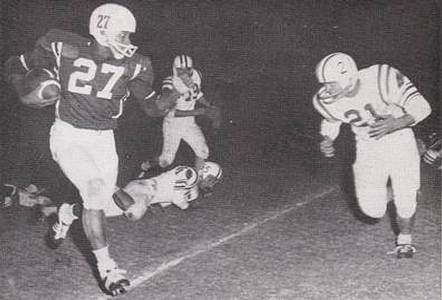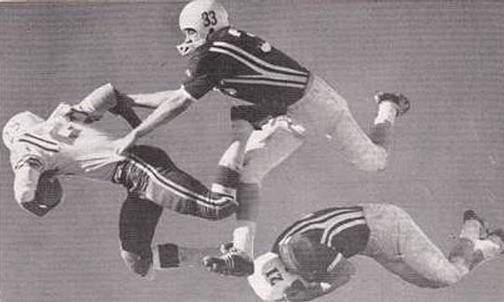

"New Mexico State 1960"
HELMET HUT NEWS/REFLECTIONS APRIL 2009:
NEW MEXICO STATE 1960
By Dr. Ken
If there was a school that few of us had heard about in the New York City area as the 1950’s rolled into the ‘60’s, it was New Mexico State University. Considered a “small college” program and playing a schedule that included McMurray, Northern Arizona, West Texas State, and what was then viewed as a small potatoes Arizona State team, the Border Conference squad had no traction in our sphere. An article in the November 7, 1960 issue of Sports Illustrated magazine changed that for me. I chided myself for being a close-minded young man and even as a nascent ninth grader, I would hold myself responsible for ignorance that as a “true fan” of college football, I felt I should have overcome. Until I saw that magazine in the local library, I had no clue that the Aggies of Las Cruces had a top-ten-in-the-nation passing or total offense attack the season before or that their halfback led the nation in rushing while their quarterback was tied for fifth in passing. By the time the 1960 season ended, I knew enough to check the statistics and found that once again, their halfback had led the nation in rushing but unbelievably, it was a different halfback then the rushing leader of ‘59! The quarterback, one destined for a fifteen-year pro career had moved to the number four spot in passing for the year. The team led the nation in both passing and total offense and ranked third in rushing. How could the country not know these guys?
Being New Mexico State probably explained the anonymity. The rivalry with isolated Texas El Paso was more heated than the one with the University Of New Mexico due to location and in the early-1970’s, as a long haul tractor-trailer driver, I got an inkling as to the ways in which the best offensive attack in the land could go unnoticed if it was located near absolutely nothing! Being more familiar with what has grown into a beautiful area and wonderful locale to work, live, and raise a family, I believe it is accurate to describe the early 1960’s version as “less populated.” The Aggies head coach was a good way through what would be a College Football Hall Of Fame career. Warren Woodson eventually finished his coaching contributions with a 203-95-14 record at the college level but won fifty-two more games as a junior college mentor. He quickly became a legend in the southwest after graduating with an eclectic mix of degrees in Bible Study and history from Baylor, and in physical education from Springfield College. Like most of his peers, his coaching career was interrupted by World War II but upon his return to Hardin-Simmons University where he had been since 1941, he immediately produced an unbeaten team for the post-War debut in 1946. He was then successful at Arizona before coming to New Mexico State in 1958. Woodson was not necessarily a popular coach, tough on his players and disliked by some of his opponents for his propensity “of running up scores to horrifying heights.” Typical was the ninety points he pounded Northern Arizona with as was his response that “You get interested in a game and don’t notice the score.” He was known to poach players off of other campuses and his refusal to shake hands with opposing coaches after the final whistle was something almost unheard of in that by-gone era of publicly demonstrated good sportsmanship. However, he won and put an exciting, high-flying team onto the field wherever he coached and New Mexico State was no exception. While his current players were garnering huge statistics, Woodson would, by the end of his career, claim players who won the national rushing title nine times with four of those at New Mexico State in consecutive seasons spanning 1959 through the 1962 seasons. Insight provided by his best quarterback, former St. Louis Cardinals, Oilers, and Broncos great Charley Johnson noted another side to Coach Woodson. Many years after his graduation Johnson said, “Coach Woodson had a list of rules we had to follow. His first rule was for us to throw the ball at least 20 times a game. His second rule was to throw the ball seven times in the first quarter. Those rules were in place to open up our outstanding running game. We were like his kids, He was a harsh disciplinarian, and he didn't want anybody else messing with us. He took care of us. He had a genuine concern for everybody on the team, but he hardly ever let it show."
The 1960 squad featured two backs who had matriculated together from California’s Santa Ana Junior College. With one of the best ever nicknames in football, halfback Pervis “Afterburner” Atkins had followed a circuitous route to NMSU. After a semester of football at San Francisco State University, he spent time in the Marine Corps. Coming to New Mexico State after one season at Santa Ana JC, he led the nation in rushing in 1959.
 |
“Afterburner” Atkins speeds around end
In 1960, his teammate and former JC All American Bob Gaiters took those same honors. With future 238 pound San Diego, Oakland, and Houston fullback Bobby Jackson a developing sophomore, the backfield was perhaps the best in the country behind quarterback Charley Johnson.
|
|
Bobby Gaiters with 49’ers in 1962
Johnson of course had a lengthy and successful fifteen season career, best known with the Cardinals and was usually underrated and overlooked relative to some of the bigger names in the NFL but even at New Mexico State, he was already an accomplished passer. With Gaiters leading the nation in scoring and also in rushing, outdistancing his nearest rival by almost three hundred yards, and Atkins the best in the country at average yards per carry, the undefeated 11-0 team should have had more recognition. The 20-13 victory over the Merlin Olsen led Utah State team in the Sun Bowl was not considered to be worthy of the same type of mention as the other major bowl games, but those in the know certainly understood that New Mexico State had one of the country’s best teams. Reflecting that, Atkins and Gaiters were All Americans and Woodson was the nation’s Coach Of The Year.
 |
Despite the plain white helmets with red numerals on each side, Woodson showed the same pizzazz in his uniform design as he did with his flashy offense. His players’ jerseys featured vertical contrasting stripes that ran shoulder to waist on both the home and away uniforms which was a very different look in that more conservative period of time. He pre-dated the influx of contrasting stretch panels that are now so prevalent on today’s crop of jerseys. Though quite a few of the 1960 Aggies went on to professional football careers, Johnson, Atkins, and Gaiters remained the best known. As a Giants fan, I noted that Bobby Gaiters was the very first draft choice of the American Football League but rebuffed the offer made by the Denver Broncos to instead sign with my hometown Giants where he filled in for the injured Frank Gifford during the 1961 season. His collegiate career scoring average of 11.9 points per game remained an NCAA record until 1992 when it was surpassed by Marshall Faulk but he didn’t have the same success as a pro. He only totaled 673 yards in his brief career with the Giants and Forty Niners and then played for the CFL Hamilton Tiger Cats for two seasons and another three in the Continental Football League. He did however find success in the recording industry after working with Bill Medley of the Righteous Brothers. Atkins pro career was a bit more successful as he totaled more than 3800 all purpose yards in a six season stay with the Rams, Redskins, and Raiders. Older than most NFL rookies after his stint in the Marines, Atkins left pro ball and also found success in the entertainment industry. Hosting a popular sports show with former Rams teammate Dick Bass, Atkins eventually became an executive with ABC and started his own agency. The Aggies’ quarterback, the man who is supposed to be the brains on the field certainly was for the 1960 squad. Charley Johnson was often noted in many articles and by sportscasters during his pro career, as being “a genius” and the Doctorate degree holder eventually returned to his alma mater as the Chairman Of The Department Of Chemical Engineering after his terrific professional career. Coach Woodson remained at New Mexico State through the 1967 season and though the winningest coach in the program’s history, a distinction he still holds to this day, he was released. The school cited the mandatory retirement age of sixty-five, Woodson claimed “politics” but he continued to coach, moving on to Trinity University in Texas where he tallied a 16-5 record in his final two years on the sidelines.
New Mexico State has had a number of good teams and a number of good players as the institution grew in size and stature, becoming a highly respected educational center in the Southwest. However, the undefeated team of 1960 remains the cornerstone of its football success and reputation, one that will not be easily duplicated.
 |
Quarterback and Chemistry Genius Johnson
[Thanks to Mr. Tyler Dunkel of New Mexico State University for his contributions to this article]